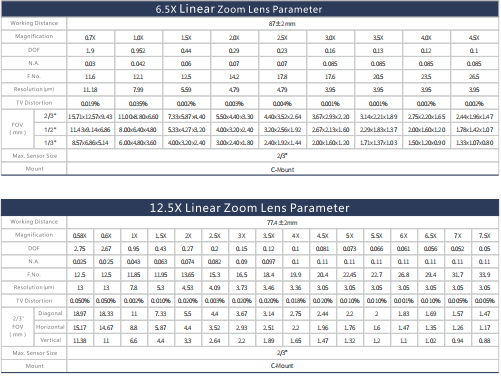Motorized zoom lenses play an important role in modern optical imaging systems, and understanding their parameters is critical to selecting and applying the right lens.

Variability Ratio
The zoom ratio is one of the most important indicators of the performance of a motorized zoom lens. It represents the ratio of the maximum focal length of the lens to the minimum focal length. For example, a lens with a 10:1 zoom ratio means that the maximum focal length is 10 times the minimum focal length. A larger zoom ratio provides a wider range of focal lengths to choose from, allowing the lens to be adapted to a wider variety of shooting scenarios and subject distances.
Focal Length Range
This parameter directly determines the angle of view and the size of the image that the lens can capture. The focal length range is usually expressed in terms of minimum and maximum focal lengths, e.g. 6 - 60 mm. shorter focal lengths (wide-angle end) allow for wider scenes, suitable for large objects or panoramas, while longer focal lengths (telephoto end) allow for distant objects to be brought closer together and zoomed in on, suitable for photographing details or close-ups in the distance.
Aperture Value
The size of the aperture affects the amount of light entering the lens and the depth of field effect. It is expressed in terms of f-number, such as f/2.8, f/4, and so on. A smaller f-number (e.g. f/2.8) indicates a larger aperture and more light intake for low-light environments, but with a shallower depth of field and noticeable background blur; a larger f-number (e.g. f/8) indicates a smaller aperture, less light intake, and a larger depth of field, with more areas of the picture remaining clear.
Resolution
Resolution determines the degree of detail that can be clearly resolved by a lens. It is usually measured in pairs of lines per millimeter (lp/mm) that can be resolved. Higher resolution lenses are able to present sharper, clearer images, especially in applications where tiny objects are photographed or where high precision imaging is required, such as circuit board inspection, medical microscopy, and so on.
Operating Distance
The working distance refers to the distance from the front of the lens to the surface of the object that can be clearly imaged. Different application scenarios may have specific working distance requirements. For example, in industrial inspection, the lens is required to be able to accurately image an object within a specific distance range, while in some medical equipment, a shorter working distance may be required to fit into a compact operating space.
Distortion
Aberration is the degree to which the shape of an object in an image is distorted relative to its true shape. It is categorized into barrel distortion and pincushion distortion. Lenses with low distortion are able to more accurately reproduce the true shape of an object, which is important for applications that require precise measurements or high geometric accuracy of the image.
Interface Type
The type of interface of the motorized zoom lens needs to be compatible with the camera or imaging device, and the common interfaces are C interface, CS interface, F interface and so on. Ensuring that the lens interface is compatible with the device is the basis for good imaging.
Understanding the parameters of the motorized zoom lens will help you select the most suitable lens for your specific application, thus obtaining high-quality imaging results.
Product recommendation
TECHNICAL SOLUTION
MORE+You may also be interested in the following information
FREE CONSULTING SERVICE
Let’s help you to find the right solution for your project!


 ASK POMEAS
ASK POMEAS  PRICE INQUIRY
PRICE INQUIRY  REQUEST DEMO/TEST
REQUEST DEMO/TEST  FREE TRIAL UNIT
FREE TRIAL UNIT  ACCURATE SELECTION
ACCURATE SELECTION  ADDRESS
ADDRESS Tel:+ 86-0769-2266 0867
Tel:+ 86-0769-2266 0867 Fax:+ 86-0769-2266 0867
Fax:+ 86-0769-2266 0867 E-mail:marketing@pomeas.com
E-mail:marketing@pomeas.com
